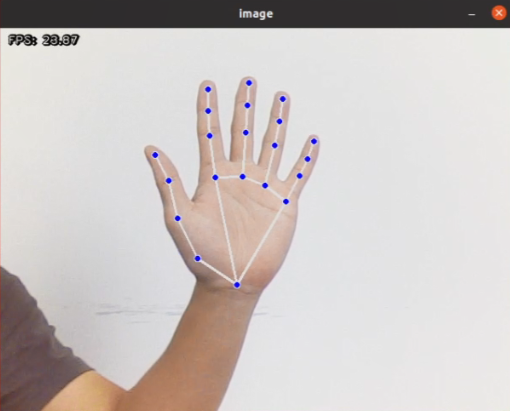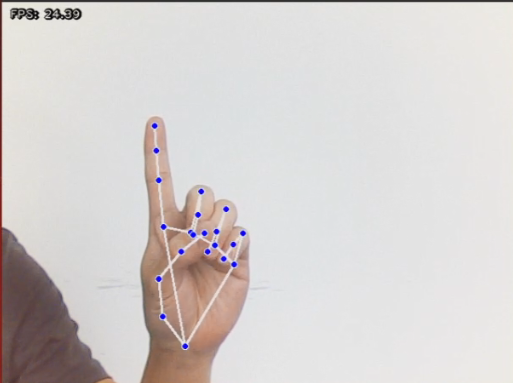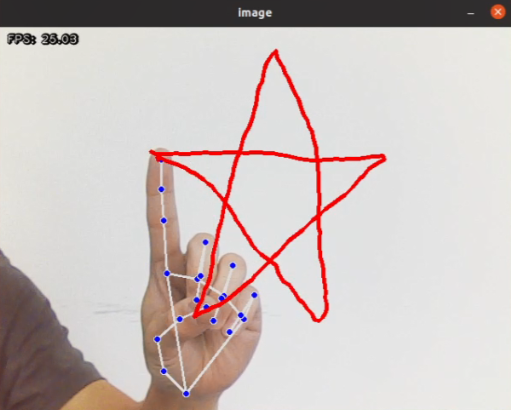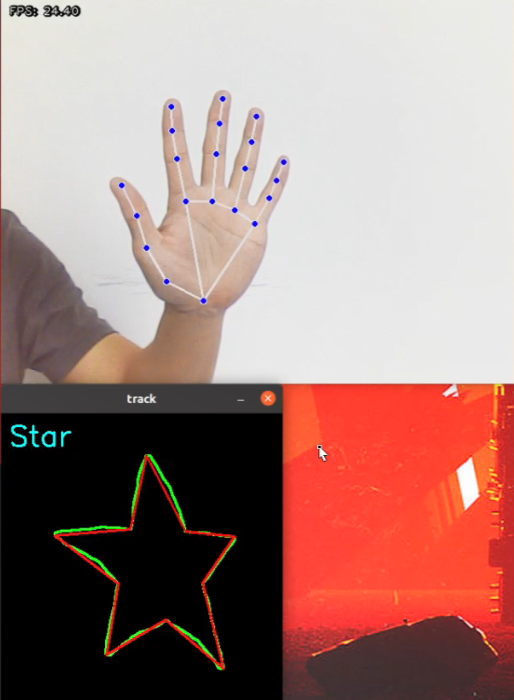Fingertip trajectory control robot arm
1. Introduction
The fingertip trajectory control robot arm function is based on fingertip trajectory recognition, adding different trajectories to control different movements of the robot arm.
2. Startup
2.1. Program description
After the program is started, the camera captures the image, put the palm flat on the camera screen, open the fingers, and the palm faces the camera, similar to the gesture of the number 5. The image will draw the joints on the entire palm. Adjust the position of the palm and try to locate it in the upper middle part of the screen.

At this time, the index finger remains unchanged, and the other fingers are retracted, similar to the gesture of the number 1.

Keep the gesture 1 unchanged, move the finger position, and a red line will appear on the screen to draw the path of the index finger.

When the figure is drawn, open all fingers, and the gesture similar to the number 5 will generate the drawn figure below.

Note: The drawn figure needs to be closed, otherwise part of the content may be missing.
There are currently four trajectory figures that can be recognized, namely: triangle, rectangle, circle, and five-pointed star.
When the camera recognizes different trajectory shapes, it will control the robot arm to perform corresponding actions.
2.2, Program Start
Enter the following command to start the program
xxxxxxxxxxros2 run dofbot_pro_mediapipe 16_FingerActionPress q in the image or press Ctrl+c in the terminal to exit the program.
3. Source code
Code path:
xxxxxxxxxx~/dofbot_pro_ws/src/dofbot_pro_mediapipe/dofbot_pro_mediapipe/16_FingerAction.py
xxxxxxxxxx#!/usr/bin/env python3# coding: utf8import osimport enumimport cv2import timeimport numpy as npimport mediapipe as mpimport rclpyfrom rclpy.node import Nodeimport queuefrom sensor_msgs.msg import Imagefrom dofbot_utils.fps import FPSimport gcfrom dofbot_utils.vutils import distance, vector_2d_angle, get_area_max_contourimport threadingfrom Arm_Lib import Arm_Devicefrom dofbot_utils.robot_controller import Robot_Controllerfrom cv_bridge import CvBridge # Importing CvBridge
def get_hand_landmarks(img, landmarks): """ 将landmarks从medipipe的归一化输出转为像素坐标 :param img: 像素坐标对应的图片 :param landmarks: 归一化的关键点 :return: """ h, w, _ = img.shape landmarks = [(lm.x * w, lm.y * h) for lm in landmarks] return np.array(landmarks)
def hand_angle(landmarks): """ 计算各个手指的弯曲角度 :param landmarks: 手部关键点 :return: 各个手指的角度 """ angle_list = [] # thumb 大拇指 angle_ = vector_2d_angle(landmarks[3] - landmarks[4], landmarks[0] - landmarks[2]) angle_list.append(angle_) # index 食指 angle_ = vector_2d_angle(landmarks[0] - landmarks[6], landmarks[7] - landmarks[8]) angle_list.append(angle_) # middle 中指 angle_ = vector_2d_angle(landmarks[0] - landmarks[10], landmarks[11] - landmarks[12]) angle_list.append(angle_) # ring 无名指 angle_ = vector_2d_angle(landmarks[0] - landmarks[14], landmarks[15] - landmarks[16]) angle_list.append(angle_) # pink 小拇指 angle_ = vector_2d_angle(landmarks[0] - landmarks[18], landmarks[19] - landmarks[20]) angle_list.append(angle_) angle_list = [abs(a) for a in angle_list] return angle_list
def h_gesture(angle_list): """ 通过二维特征确定手指所摆出的手势 :param angle_list: 各个手指弯曲的角度 :return : 手势名称字符串 """ thr_angle, thr_angle_thumb, thr_angle_s = 65.0, 53.0, 49.0 if (angle_list[0] < thr_angle_s) and (angle_list[1] < thr_angle_s) and (angle_list[2] < thr_angle_s) and ( angle_list[3] < thr_angle_s) and (angle_list[4] < thr_angle_s): gesture_str = "five" elif (angle_list[0] > 5) and (angle_list[1] < thr_angle_s) and (angle_list[2] > thr_angle) and ( angle_list[3] > thr_angle) and (angle_list[4] > thr_angle): gesture_str = "one" else: gesture_str = "none" return gesture_str
class State(enum.Enum): NULL = 0 TRACKING = 1 RUNNING = 2
def draw_points(img, points, tickness=4, color=(255, 0, 0)): """ 将记录的点连线画在画面上 """ points = np.array(points).astype(dtype=np.int32) if len(points) > 2: for i, p in enumerate(points): if i + 1 >= len(points): break cv2.line(img, tuple(p), tuple(points[i + 1]), color, tickness)
def get_track_img(points): """ 用记录的点生成一张黑底白线的轨迹图 """ points = np.array(points).astype(dtype=np.int32) x_min, y_min = np.min(points, axis=0).tolist() x_max, y_max = np.max(points, axis=0).tolist() track_img = np.full([y_max - y_min + 100, x_max - x_min + 100, 1], 0, dtype=np.uint8) points = points - [x_min, y_min] points = points + [50, 50] draw_points(track_img, points, 1, (255, 255, 255)) return track_img
class FingerActionNode(Node): def __init__(self): super().__init__('finger_action') self.drawing = mp.solutions.drawing_utils self.timer = time.time() self.move_state = False
self.hand_detector = mp.solutions.hands.Hands( static_image_mode=False, max_num_hands=1, min_tracking_confidence=0.05, min_detection_confidence=0.6 )
self.fps = FPS() # fps计算器 self.state = State.NULL self.points = [] self.start_count = 0 self.no_finger_timestamp = time.time()
self.gc_stamp = time.time() self.image_queue = queue.Queue(maxsize=1) self.bridge = CvBridge()
# Initialize video capture device self.cap = cv.VideoCapture(0, cv.CAP_V4L2) self.cap.set(cv2.CAP_PROP_FRAME_WIDTH, 640) self.cap.set(cv2.CAP_PROP_FRAME_HEIGHT, 480) if not self.cap.isOpened(): self.get_logger().error("Error: Could not open video device.") rclpy.shutdown()
self.Arm = Arm_Device() self.robot = Robot_Controller() self.robot.move_init_pose()
def image_proc(self): ret, frame = self.cap.read() if not ret: self.get_logger().error("Error: Could not read frame from video device.") return
rgb_image = cv2.cvtColor(frame, cv2.COLOR_BGR2RGB) rgb_image = cv2.flip(rgb_image, 1) # 水平翻转 result_image = np.copy(rgb_image) result_call = None if self.timer <= time.time() and self.state == State.RUNNING: self.state = State.NULL try: results = self.hand_detector.process(rgb_image) if self.state != State.RUNNING else None if results is not None and results.multi_hand_landmarks: gesture = "none" index_finger_tip = [0, 0] self.no_finger_timestamp = time.time() # 记下当期时间,以便超时处理 for hand_landmarks in results.multi_hand_landmarks: self.drawing.draw_landmarks( result_image, hand_landmarks, mp.solutions.hands.HAND_CONNECTIONS) landmarks = get_hand_landmarks(rgb_image, hand_landmarks.landmark) angle_list = (hand_angle(landmarks)) gesture = (h_gesture(angle_list)) index_finger_tip = landmarks[8].tolist()
if self.state == State.NULL: if gesture == "one": # 检测到单独伸出食指,其他手指握拳 self.start_count += 1 if self.start_count > 20: self.state = State.TRACKING self.points = [] else: self.start_count = 0
elif self.state == State.TRACKING: if gesture == "five": # 伸开五指结束画图 self.state = State.NULL
# 生成黑白轨迹图 track_img = get_track_img(self.points) contours = cv2.findContours(track_img, cv2.RETR_EXTERNAL, cv2.CHAIN_APPROX_NONE)[-2] contour = get_area_max_contour(contours, 300) contour = contour[0] # 按轨迹图识别所画图形 # cv2.fillPoly在图像上绘制并填充多边形 track_img = cv2.fillPoly(track_img, [contour, ], (255, 255, 255)) for _ in range(3): # 腐蚀函数 track_img = cv2.erode(track_img, cv2.getStructuringElement(cv2.MORPH_RECT, (5, 5))) # 膨胀函数 track_img = cv2.dilate(track_img, cv2.getStructuringElement(cv2.MORPH_RECT, (5, 5))) contours = cv2.findContours(track_img, cv2.RETR_EXTERNAL, cv2.CHAIN_APPROX_NONE)[-2] contour = get_area_max_contour(contours, 300) contour = contour[0] h, w = track_img.shape[:2]
track_img = np.full([h, w, 3], 0, dtype=np.uint8) track_img = cv2.drawContours(track_img, [contour, ], -1, (0, 255, 0), 2) # 对图像轮廓点进行多边形拟合 approx = cv2.approxPolyDP(contour, 0.026 * cv2.arcLength(contour, True), True) track_img = cv2.drawContours(track_img, [approx, ], -1, (0, 0, 255), 2) graph_name = 'unknown' print(len(approx)) # 根据轮廓包络的顶点数确定图形 if len(approx) == 3: graph_name = 'Triangle' if len(approx) == 4 or len(approx) == 5: graph_name = 'Square' if 5 < len(approx) < 10: graph_name = 'Circle' if len(approx) == 10: graph_name = 'Star' cv2.putText(track_img, graph_name, (10, 40), cv2.FONT_HERSHEY_SIMPLEX, 1.2, (255, 255, 0), 2) cv2.imshow('track', track_img) if not self.move_state: self.move_state = True task = threading.Thread(target=self.arm_move_action, name="arm_move_action", args=(graph_name,)) task.setDaemon(True) task.start()
else: if len(self.points) > 0: if distance(self.points[-1], index_finger_tip) > 5: self.points.append(index_finger_tip) else: self.points.append(index_finger_tip)
draw_points(result_image, self.points) else: pass else: if self.state == State.TRACKING: if time.time() - self.no_finger_timestamp > 2: self.state = State.NULL self.points = []
except BaseException as e: self.get_logger().error("e = {}".format(e))
self.fps.update_fps() self.fps.show_fps(result_image) result_image = cv2.cvtColor(result_image, cv2.COLOR_RGB2BGR) cv2.imshow('image', result_image) key = cv2.waitKey(1)
if key == ord(' '): # 按空格清空已经记录的轨迹 self.points = [] if time.time() > self.gc_stamp: self.gc_stamp = time.time() + 1 gc.collect()
def arm_move_triangle(self): self.Arm.Arm_serial_servo_write6_array([90, 131, 52, 0, 90, 180], 1500) time.sleep(1.5) self.Arm.Arm_serial_servo_write6_array([45, 180, 0, 0, 90, 180], 1500) time.sleep(2) self.Arm.Arm_serial_servo_write6_array([135, 180, 0, 0, 90, 180], 1500) time.sleep(2) self.Arm.Arm_serial_servo_write6_array([90, 131, 52, 0, 90, 180], 1500) time.sleep(1.5)
def arm_move_square(self): self.Arm.Arm_serial_servo_write6_array(self.robot.P_ACTION_4, 1500) time.sleep(1.4) for i in range(3): self.Arm.Arm_serial_servo_write(4, -15, 300) time.sleep(0.4) self.Arm.Arm_serial_servo_write(4, 20, 300) time.sleep(0.4)
def arm_move_circle(self): for i in range(5): self.Arm.Arm_serial_servo_write(5, 60, 300) time.sleep(0.4) self.Arm.Arm_serial_servo_write(5, 120, 300) time.sleep(0.4) self.Arm.Arm_serial_servo_write(5, 90, 300) time.sleep(0.4)
def arm_move_star(self): for i in range(3): self.Arm.Arm_serial_servo_write6_array(self.robot.P_ACTION_3, 1200) time.sleep(1.2) self.Arm.Arm_serial_servo_write6_array(self.robot.P_LOOK_AT, 1000) time.sleep(1)
def arm_move_action(self, name): self.Arm.Arm_Buzzer_On(1) time.sleep(1) if name == 'Triangle': self.arm_move_triangle() elif name == 'Square': self.arm_move_square() elif name == 'Circle': self.arm_move_circle() elif name == 'Star': self.arm_move_star() self.robot.move_init_pose() time.sleep(1.5) self.move_state = False
def main(args=None): rclpy.init(args=args) finger_node = FingerActionNode() try: while rclpy.ok(): finger_node.image_proc() except KeyboardInterrupt: pass finally: finger_node.cap.release() cv2.destroyAllWindows() rclpy.shutdown()
if __name__ == "__main__": main()